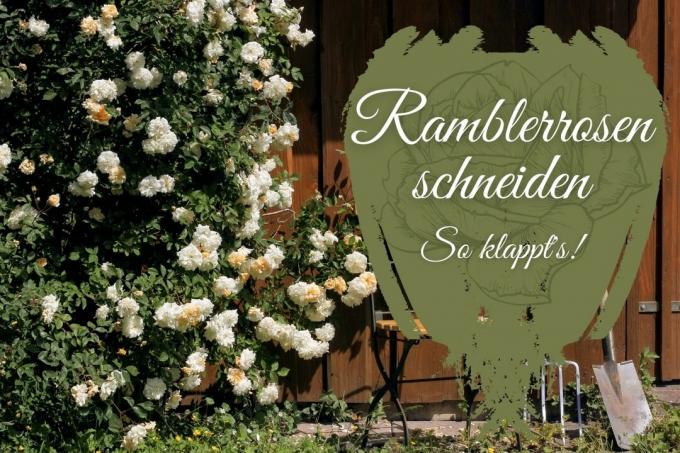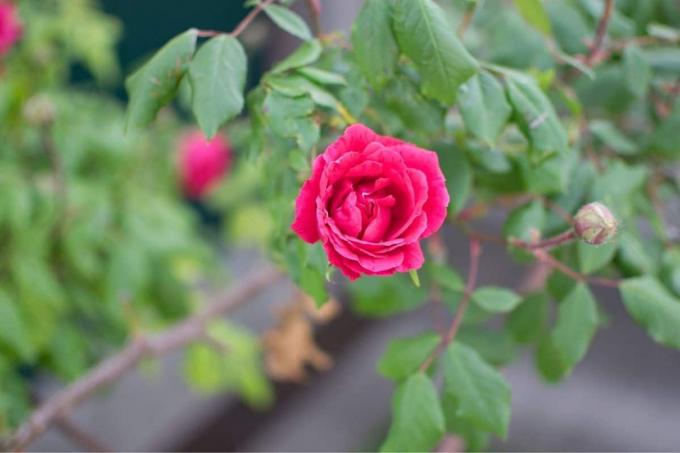
table of contents
- Rambler roses
- Heyday
- Time for the cut
- Cutting once-flowering varieties - instructions
- Cutting multiple blooming varieties - instructions
- frequently asked Questions
The rambler rose is the first choice for anyone looking for a fast growing, free flowering rose. When is the right time to prune and what should be considered when pruning the rambler rose?
In a nutshell
- Take into account varietal characteristics when cutting
- Differentiation between single and multiple flowering rambler roses
- Cut roses that bloom once immediately after blooming
- multiple flowering varieties before flowering in spring
- Regular cleaning of dead flowers is recommended
Rambler roses
Rambler roses are characterized by many small flowers on climbing stems. Therefore, breeding from the Asian varieties Wichura rose (Rosa wichuraiana) and the richly blooming panicle rose (Rosa multiflora) inspires rose lovers.
The name "Ramblerrose" comes from English. "To ramble" means something like "to wander around". The rose species therefore has particularly soft, long and flexible shoots that quickly green rose arches or walls. Often it is also called "loop rose".

The fairytale abundance of flowers is only possible with the right cut. This depends, among other things, on which subgroup the roses belong to. We show you what to look out for.
Subgroups
Rambler roses are divided into
- varieties that bloom once
- multiple flowering varieties
Heyday
Rambler roses that bloom once are divided into early and late bloomers. With the early blooming ramblers, the blossoms unfold from mid-May to mid-June.
Late flowering varieties start flowering in mid-June. The flowering period ends in the second week of July.
Multiple blooming rambler roses bloom from spring to autumn.

Time for the cut
Ramblers that bloom once are not pruned for the first two years. From the third year onwards, the rambler rose is cut immediately after flowering, between June and July.
Young, multiple-flowering varieties receive the cut after the last flowering. In this way, nice branches form.
Older specimens that flower multiple times receive the cut before flowering, in spring before the first shoot.
Use for the Rose cut a clean, sharp pair of secateurs. With sharp blades, you can create clean cut surfaces that can heal well. Protect yourself with gloves, because rambler roses not only have many flowers but also many spines.
Cutting once-flowering varieties - instructions
- Distinguish old and young shoots. Ramblers only bloom on shoots from the previous year. You must not accidentally cut these off.
- Then remove dead and dried out parts of the plant.
- Shorten the shoots no more than the fourth eye.
- Remove the clippings.
- Clean the tool.

Note: Rambler roses grow very quickly. If your plant is spreading too much, you can stem it by pruning it back.
Cutting multiple blooming varieties - instructions
- Cut back the shoots of older specimens in spring and those of young plants in autumn to the fourth eye at most.
- Remove the clippings.
- Clean the tool.
- Water and fertilize the rose after cutting.
Note: Cut older, multiple-flowering rambler roses as little as possible. You don't need to be so careful with young specimens. With them, the vitality and the formation of new buds are strengthened by pruning.
frequently asked Questions
The flowers of the rambler rose often do not fall off on their own. The regular removal of dead flowers increases the formation of new buds and thereby strengthens the vitality of the plant. Wilted flowers that become damp are often the target of fungi and other pathogens. Regular cleaning also increases the attractiveness of the rose.
The rambler rose quickly climbs the trunk and branches of a fruit tree. Even if the combination is very decorative, you should consider the effects beforehand. Remember that the rose reduces the incidence of light in the treetop and that there must be sufficient load-bearing capacity. The prickly shoots can make harvesting difficult and cause injuries.
Secateurs are divided into anvil and bypass shears. The models declared as rose shears are bypass shears. Two blades run into one another and cut the cut piece from both sides. This creates smooth cut surfaces that can heal well. Bruising is prevented. Prefer bypass scissors for your roses and flowering plants.

